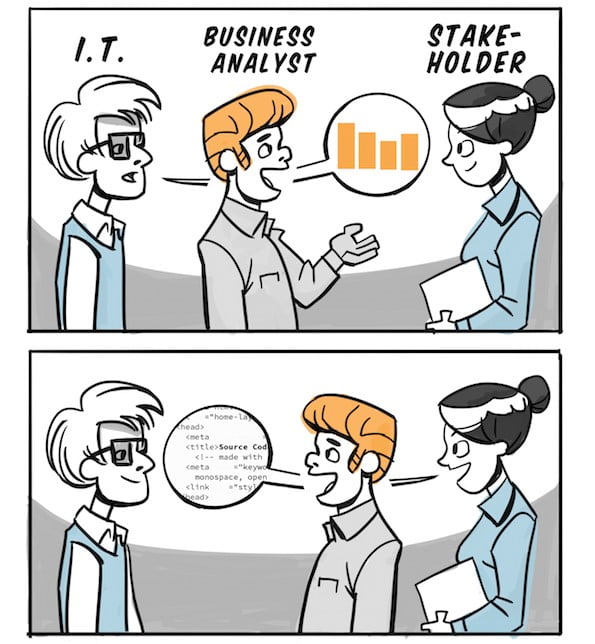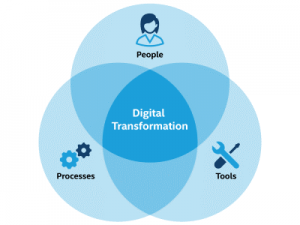
The role of business analysts in the new age of digital transformation
The world of business has changed. More and more sales and services are happening in the digital world, for example, the transition from bank tellers to online bill payments. This digitisation of business has not come naturally (and in the case of banking – easily) but it is here and is here to stay.
Business analysts are often the people driving (or at least behind) these changes. But what does a business analyst do?

A business analyst (analyst) is defined as one who “interacts with the business stakeholders and subject matter experts to understand their problems and needs. The analyst gathers, documents, and analyses business needs and requirements. The analyst solves business problems and, as needed, designs technical solutions.” (Villanova University, 2020)
In other words, it is the analyst’s job to translate business processes among the various stakeholders.
They need to translate the understanding of what happens in a business so that every department and stakeholder has the same understanding of the project and the processes. It is the business analyst’s role to streamline across organisations and try to interpret the technical complexities that exist.
Business analysts are at the forefront of digital transformation as they are the ones who not only define the process but who understand the process. They can find ways to best implement a digital transformation, at least from a high level.
And what is digital transformation?
Digital transformation is enabling new ways to deliver value to customers. Companies like Google, Apple, Amazon, Netflix and eBay, to name a few, have changed the landscape and in essence, are changing the way that we deal with the world. Globalisation has been a significant result of digital transformation as it is now easier to communicate and work from anywhere and at any time, so as long as there is an internet connection.
The analyst needs to stay on top of the four main types of digital transformation:
- Business process
- Business model
- Domain; and
- Cultural/organisation

This is to ensure that they can guide their organisation through the maze of digital technologies available, they need to document what is happening with people (the stakeholders), processes and technologies used.
For example, it is no good suggesting to modernise a system when there is no understanding on how to fulfil the new process i.e. staff are not trained and/or there is no reference documentation (even if the appropriate technology is in place).
With businesses moving towards digital transformation, it is essential to note the following potential problematic outcomes:
- Solutions are created, but not used.
- Solutions are taking too long to be developed and become irrelevant before being used.
- Solutions are costing too much.
- Solutions are not meeting expectations.
These problems cause much frustration for stakeholders as we can see in the following real-life examples (company names withheld):
Example: Student portal for law society
A law society creates a student portal for their students which no one uses.
In this example, the analyst went through all the usual steps of mapping the process, talking to stakeholders, creating a business model, ensuring it is in the right place (domain). With help from the project manager, the subsequent portal was built on time and within budget. Unfortunately, the students (the customers) were not using it!
Why? Because it was on the wrong platform. Students, as a general rule, use mobile phones or tablets and this solution was built for a browser. For the students this solution felt clunky and was difficult to use, so they went elsewhere to find the information required. In this case, the business analyst needed to truly understand what the targeted customers wanted and needed, and not what the analyst thought they wanted.

Example: Bubble-gum company online store
A bubble-gum company sets up an online store and finds that more of its sales are through Amazon than its own website.
In this example, a business analyst was employed to assist the process of building an online store. The analyst mapped processes and the shop was created.
By the time this had completed, the world of online shopping had moved forward. Customers no longer visit specific shops to buy items when a single online store sells every item imaginable.
In this case, the online shop had become irrelevant long before it was ever used.

Example: Car company interactive app
A car company wants to develop an interactive app that can be used in the car, on any device and be streamlined and usable within the country regulations of every country the car is sold in.
This project started off as “connect a mobile phone app to a car”. The business analyst produced the “how-to” or “should be” for this particular project. However, due to the ineffective project governance, issues like scope creeping and gold plating of features eventuated.
The car company soon realised that it would cost much more than original planned, so it was scrapped completely.

Example: Microsoft Teams
It is not just small companies that can sometimes overlook their solutions and fail to meet their customers basic expectations.
Microsoft’s collaboration platform Teams and OneNote did not meet the needs of schools in term 2, 2020. What? Microsoft? How? Quite simple, their business analysts did not foresee the structural implications (both in hardware and software) for the huge numbers of users engaging with the services on the first day back. This led to the degradation of services, in effect, and some unhappy customers right across Australia. It is the analysts role to identify and document these “as is” processes and find a resolution in future “should be” processes. By doing so, Microsoft may have been able to adjust people, processes and technology in such a manner that would have avoided the negative customer impacts. This is to some extent a simplified view of the event as there are likely to have been other factors at play, but it is important to acknowledge the critical role that the business analyst plays..

Ensuring that businesses are prepared for future digital transformation is a key focus of the skilled business analyst. Ensuring that businesses have the appropriate process and the right technologies are key to staying competitive in the current digital climate. Organisation needs to make the right informed decisions – making the wrong decision can be catastrophic and very costly.
Organisations need to accept that digital transformations can be much more complicated than traditional business improvements have been in the past, but the success can be of higher magnitude. As seen, even digital-savvy industries and companies such as Microsoft, at times, struggle to keep up. However more traditional industries, such as oil and gas, automotive, infrastructure, banking and pharmaceuticals, can find it even more difficult. Decades of tradition and outdated methodologies need to be broken down, dissected and revamped within organisations that have large, long-term staff and fixed, often rigid, cultures.

Conclusion
All trends show that society is moving faster and faster towards a digital world and experiences, so these companies should look forward by:
- Reimagining their workplace – try and imaging what a “perfect digital company” would be like. What does a positive or outstanding experience look like for your customer?
- Upgrade the organisations “Hard Wiring” – try and find digital tools that will do the traditional jobs that are currently being performed – allow your people to focus on more important positive customer experience delivering activities.
- Communicate differently – Good communication has always been important in traditional companies, and that is no different in a digitally transformed world.
References
Bytyci, R. (2020, April 26). The Future of Business Analysis. Retrieved from BA Times: https://www.batimes.com/articles/the-future-of-business-analysis.html
McKinsey & Company. (2018, October). Unlocking success in digital transformations. Retrieved from McKinsy & Company Organisation: https://www.batimes.com/articles/the-future-of-business-analysis.html
Skracic, L. (2015, March 24). So what does a business analyst actually do? Retrieved from elabor8: https://elabor8.com.au/what-does-a-business-analyst-actua
Villanova University. (2020, January 16). Business Analysis Career Path. Retrieved from Villanova University: https://www.villanovau.com/resources/business-analysis/business-analyst-career/
Are you interested in knowing more about it?
Let’s talk, we can help you!
Check out the Lucid Insights blog
There is a variety of content that may help you to improve your business!







